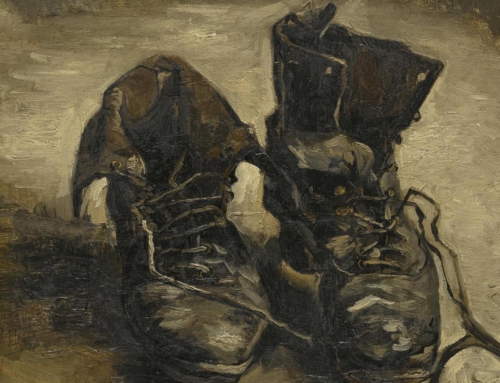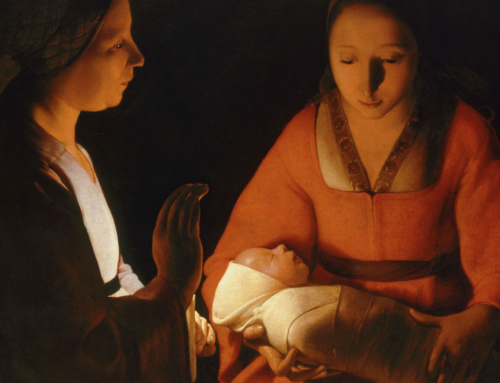The words “information” and “ecstasy” are not easily brought together. Even the recent fad of nerd-glorifying shows like Chuck and The Big Bang Theory would have a hard time of it. But fear not: what today’s nerds consider impossible, the scholastic doctors were able to accomplish. Not only did they bring together these seemingly disparate concepts, they discovered and articulated profound connections between them. Today, I invite you to join me on an equally bold—and nerdy—endeavor: taking these connections and applying them to how we spend the last days of Lent.
Information: The word “information” didn’t mean for the scholastics what it means for us. To modern ears, information is the “data” that fills a computer (or, for the antiquarian, a “book,” which is like a Nook, minus scrolling, plus page-turning). For the scholastics, “in-formation” is when one thing receives the form of another. The link between this understanding and our modern way of speaking is knowledge: for St. Thomas, to know a thing is to receive its form into your intellect. It is being in-formed.
This approach to knowledge has interesting metaphysical and ethical implications. First, knowledge is a union between knower and known. Second, this union is immanent; it occurs by taking what is “out there” and bringing it “in here.” Third, and perhaps most importantly, the form that is received is changed by this union. When we know lower, material things, their forms are elevated by this knowledge, since they are freed from the constantly changing matter in which we find them and are given a share in our own intellectual existence. By contrast, when we know higher, immaterial things, the opposite happens. We can’t completely comprehend God or the angels, so when we grasp them with our minds, we have to bring them down to “our level.” So the information of our mind is an interior union that elevates what is lower and “degrades” what is higher.
Ecstasy: Luckily, “ecstasy” has basically the same meaning today that it has always had. It is a going-out-of-oneself. Moreover, for both contemporaries and medievals, ecstasy is intimately connected with love. The only difference, really, is that the scholastics had a richer, broader definition of love that included within it everything that could fall under the heading of “attraction to the good.” Thus, just as “information” naturally goes with the intellect because of its relation to knowledge, “ecstasy” naturally goes with the will because of its relation to love: when you love something, you go for it.
But there’s a significant difference between information and ecstasy, knowledge and love. While love, like knowledge, is a union between lover and beloved, it isn’t an immanent union. Love doesn’t bring the beloved inside the lover, as knowledge does; rather, it moves the lover beyond himself, towards the beloved. That’s why the union of love is an ecstatic union. This has the result of reversing the effects that we saw with knowledge. When we love things that are beneath us, they aren’t brought up to our level. Rather, we are brought down to theirs. Similarly, when we love things that are above us, our love doesn’t degrade them; it elevates us. So love is an ecstatic union that conforms the lover to that which he loves.
Lent: What, you might ask, does any of this have to do with how we spend the last days of Lent? I would like to propose that the various vicissitudes of information and ecstasy offer us a novel (and hopefully fruitful) way to think about the three traditional Lenten practices: prayer, fasting, and almsgiving.
Prayer is the raising of the mind and the heart to God. Since God is far above our minds, we must pray humbly, for we are praying to the God who far outstrips the ideas we have of Him. Moreover, since God is the perfect and highest good, we are made better and more perfect by our ecstatic impulse to be united to Him. The fact that we cannot comprehend God doesn’t for an instant hinder us from loving Him. In fact, the reason we can understand Him less is the very reason why we should love Him more.
Fasting can been seen in a similar light. If we want to love God more, we need to conform ourselves to created things less. The more ecstatic we are about food (for example), the less ecstatic we will be about God. And the more we are conformed to lower things, the more inclined we will be to forget that they are, in fact, lower. So fasting serves to remind us what our real priorities should be.
As with prayer and fasting, so with almsgiving. Original sin inclines us to think of others as lower than we are, and to despise them for it. The practice of almsgiving is not merely about remembering that others are our equals. It is about seeing beyond their sins and failings straight to the image of God within them, while at the same time setting our own sins before our eyes. It is about setting others above ourselves and loving them for God’s sake.
Seen in this scholastic light, the three traditional practices of prayer, fasting, and almsgiving serve to draw us deeper into the very heart of the Christian life: loving God above all things and our neighbor as ourselves.
✠







